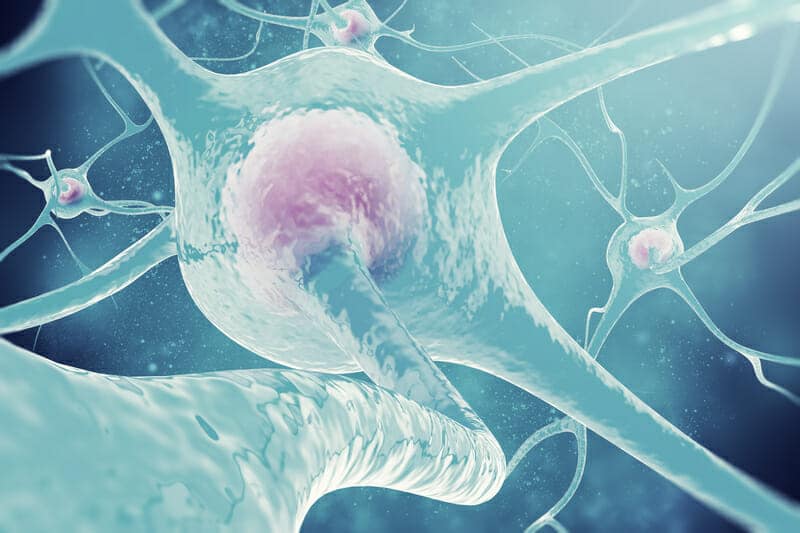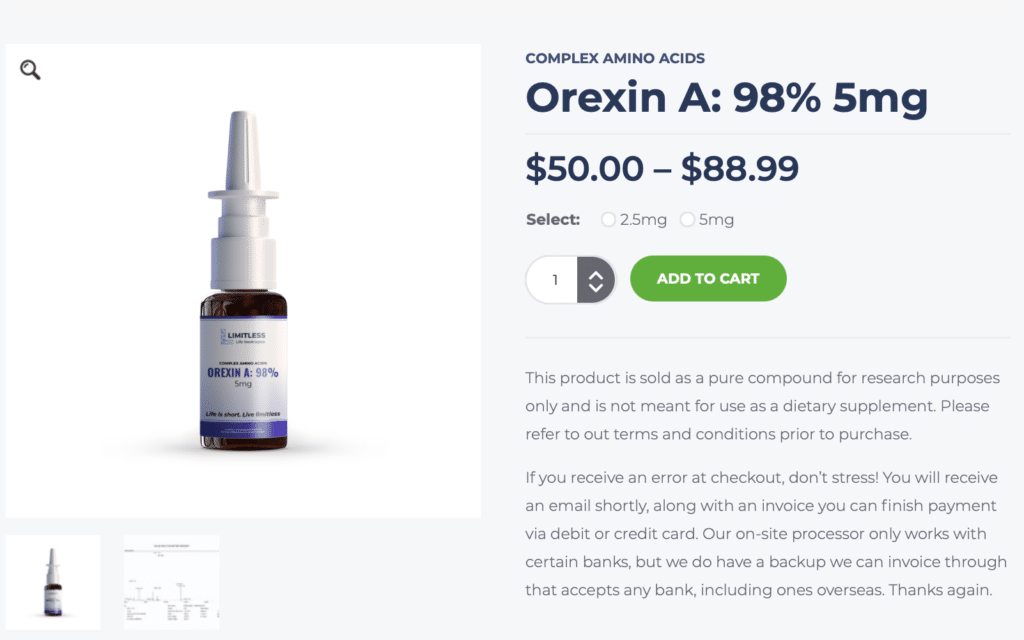It’s common for people to feel sleepy during the day — even the most energetic people end up yawning a few times throughout the day.
But if you’re crashing multiple times a day into deep sleep when you’re supposed to be working, you may be a victim of narcolepsy:
“Narcolepsy is a neurological disease affecting ~1 in 2,000 individuals in the United States, characterized by chronic daytime sleepiness, sleep attacks, and possibility of cataplexy, hypnagogic hallucinations and sleep paralysis.
These symptoms are not necessary to be present all together and narcolepsy may be identified and diagnosed by standard polysomnography (PSG) at all ages, including childhood”
And all of this has to do with the lowered production of a sleep peptide called Orexin A.
Emerging research shows Orexin A can be a potent therapy against this disease, but what about using it for enhanced mental performance?
Can Orexin A be used as a way to sustain wakefulness for longer periods of time throughout the day with feeling tired?
And will it work in people who don’t suffer from narcolepsy?
This article will tell you about Orexin A’s applications for better alertness… and a lot more!
Table of Contents
ToggleWhat Is Orexin A?

Orexin A (a.k.a. hypocretin-1) is a 33-amino-acid long neuropeptide that is located in the lateral hypothamalus of your brain.
Its discovery dates back to 1998 as a happy accident when researchers were examining new drug targets for treating obesity through the targeting of one’s appetite:
“It was reasoned that genes expressed selectively in the hypothalamus might have medically useful effects because of the role of the hypothalamus in control of appetite, thirst, pituitary hormones and many other autonomic and arousal functions.
Sutcliffe’s group in San Diego used subtractive hybridization to identify such genes. Two peptides derived from a single gene were identified and named the hypocretins, for their hypothalamic location and sequence homology to secretin”
Yet when Japanese researchers identified these peptides via other means, they were named “orexins” (i.e. Orexin A and Orexin B) instead.
Studies in mice found these peptides were indeed effective for reducing food intake (although not significantly) when the receptor that Orexin A attaches to — orexin receptor 1 (OXR1) — was blocked.
The truly surprising finding, however, was sudden interruptions in their movement that closely mimicked the behavior of humans who were diagnosed with narcolepsy.
“[Chemelli et al.] found that mice without the hypocretin-2 receptor [OXR2] experienced slow cessations of movement that they concluded were sleep attacks. They found that mice lacking the hypocretin-1 receptor had disrupted sleep but showed fewer of the signs of narcolepsy than the type 2 receptor knockouts”
Furthermore, the two types of narcolepsy involve the degradation of orexin-producing neurons:
“Narcolepsy with cataplexy is characterized by a loss of approximately 90% of hypocretin (Hcrt) neurons. However, more than a quarter of narcoleptics do not have cataplexy and have normal levels of hypocretin in their cerebrospinal fluid, raising the possibility that their disease is caused by unrelated abnormalities.”
Neither of the narcolepsy without cataplexy patients had a loss of Hcrt axons in the anterior hypothalamus. The narcolepsy without cataplexy patient whose entire brain was available for study had an overall loss of 33% of hypocretin cells compared to normals, with maximal cell loss in the posterior hypothalamus”
(FYI: Type 1 Narcolepsy is narcolepsy with cataplexy, the sudden loss of muscle strength and control. Type 2 Narcolepsy is narcolepsy WITHOUT cataplexy)
In other words… Type 1 Narcolepsy involves the destruction of orexin-producing neurons in the hypothamalus, while Type 2 narcolepsy involves the destruction of orexin-producing neurons in a more localized region of the hypothamalus.
This was a pivotal discovery for understanding why Orexin A is essential for regulating alertness:
“During the active period, the orexin peptides (orexin-A and -B) increase the activity of neurons in many brain regions that promote wakefulness and regulate REM sleep
In mouse models of narcolepsy, a lack of orexin signaling results in low levels of arousal during the active period with much shorter bouts of wakefulness, reduced locomotor activity, and cataplexy.
Most likely, in the absence of orexins, the activities of wake-promoting and REM sleep-regulating brain regions are unstable, resulting in frequent transitions into sleep and intrusions of cataplexy.”
Orexin A was not only found to be produced in many areas within the brain, but its role expanded far beyond narcolepsy:
“Numerous studies over the past 20 years have demonstrated that hypothalamic OX neurons and their projections have broader functions beyond homeostatic food intake, controlling a range of other adaptive behaviors such as sleep-wake regulation, mating, and maternal behavior”
“A remarkable feature of OX is that, despite its restricted expression in a discrete set of predominantly hypothalamic nuclei, the neurons expressing this neuropeptide project widely to brain regions involved in feeding, arousal, and hormone release”
So how exactly does Orexin A exert its wakefulness-enhancing effects on the brain?
How Does Orexin A Affect Sleep?

Orexin A’s mechanism is fairly complex but can be explained in far simpler terms:
“…the primary role of orexins is to control sleep and excitement, and the neurons that release orexins are most active during the day.
To keep us awake, these neuropeptides stimulate other neurons to release alert neurotransmitters such as dopamine, serotonin, and norepinephrine…. Orexins activate orexin neurons, monoaminergic and cholinergic neurons in the hypothalamus/brainstem regions to maintain a long, consolidated waking period.
Many cases of narcolepsy are thought to be caused by a lack of a brain chemical called hypocretin (also known as orexin) that regulates sleep. The deficiency is assessed as the result of the immune system incorrectly attacking parts of the brain that produce hypocretin.”
Many scientists believe it is an autoimmune reaction that is triggered by genes which increase the risk for narcolepsy to develop, combined with an “immunity-activating” event and a moment of vulnerability:
“Researchers are now beginning to identify some of the triggers for this autoimmune attack on the hypocretin neurons. Just after the onset of narcolepsy, people tend to have increased levels of antibodies against streptococcus, the bacteria that causes strep throat and other infection”
“In the last few years, several research labs have found that adults and children with narcolepsy may have T cells, a type of immune system cell, that selectively target the orexin peptides. These T cells may directly kill the orexin neurons, or more likely, they trigger other immune cells to damage and kill the orexin neurons.”
Unsurprisingly, narcolepsy is accompanied by an increase in pro-inflammatory factors that lead to whole body inflammation.
This is what leads to the idea that increasing Orexin A levels can help reverse the symptoms of narcolepsy.
The YouTube video below is a great primer on the biological sequences of action involved in the development of narcolepsy:
Benefits of Orexin A

With nearly 4,000 published medical papers between 1998 and the time of this writing (August 2021), Orexin A has been extensively studied as both a treatment and an important neuropeptide.
But what are the direct health benefits of Orexin A if we treat it as the former?
The evidence you’re about to see demonstrates we can use what’s in our body and accelerate its effects for better cognitive health.
Orexin A and Wakefulness
While it should be fairly obvious Orexin A is critical for maintaining a normal circadian rhythm, the big question is whether we can directly use the peptide as a treatment for people with narcolepsy.
In rats, Orexin A administration helped the animals become more attentive:
“Infusions of orexin A into the basal forebrain attenuated distracter-induced decreases in attentional performance. Orexin A attenuated deficits in lesioned animals when a visual distracter was presented.
Conclusion: The present results support the view that orexin A can enhance attentional performance via actions in the basal forebrain and may be beneficial for some conditions characterized by attentional dysfunction due to disruption of cortical cholinergic inputs.”
And just in 2020, another rat study found Orexin A showed therapeutic potential for treating age-related cognitive dysfunction:
“intranasal OxA significantly increased c-Fos expression in the agranular insular cortex. Importantly, this brain region is an important part of the circuit that controls interoceptive attention, a function crucial to an organism’s ability to detect changes to its internal physiological state.
Prior work suggests that interoceptive awareness declines with age and may predict cognitive decline in the elderly”
When rhesus monkeys sleep-deprived for 30-36 hours were given an intranasal solution of Orexin A, the peptide “pronounced reversal of sleep deprivation-induced changes in brain metabolic activity” (Source).
But the good news doesn’t stop there, as we have several human studies confirming the effectiveness of this approach:
- In one double-blind placebo-controlled experiment, patients with narcolepsy and cataplexy had faster reaction times and fewer “false reaction” when they took Orexin A intranasally
- In a separate experiment with similar conditions and patients, intranasal Orexin A restored “the wake-REM-sleep instability in patients with narcolepsy with cataplexy” (Source)
- In inattentive ADHD children who have not yet taken drugs for their condition, their blood levels of Orexin A are significantly lower
- Yet in teenagers who suffer from Internet Gaming Disorder, Orexin A levels are much higher (while also having higher expression of melatonin and lower expression of BDNF)
It’s one thing to observe all of this in people with narcolepsy… but what happens when otherwise healthy people choose to put additional amounts of Orexin A into their body from an outside source?
As it turns out, several people on Reddit have done their own experiments and the conclusions are promising:
- An undergraduate math major felt more focused and had a mood lift, claiming he can “study without methylphenidate” when he couldn’t in prior attempts
- Another student diagnosed with narcolepsy claimed he could study “without the strong urge to fall asleep”, stating that Modafinil and dexamphetamines would agitate him
- One individual felt a near-instant effect with mental clarity to the point where he can get out of bed after being in a brain-dead state
- A narcolepsy type 2 patient (i.e. without cataplexy) said Orexin A was “the single best substance I’ve ever tried”, cutting down his reliance on Armodafinil in half
- One biohacker said he felt awake to the point where it was as if he slept well, and had “almost forgotten what the morning felt like”
- A medical student felt Orexin A helped him process information better and answer complex questions correctly, while Modafinil did not address the negative effects of his sleep deprivation
- 10 hours into a 2nd consecutive 14-hour shift, a medical surgery worker said Orexin A was “thrillingly effective to combat sleep-deprivation induced fatigue and brain fog”, even more than N-Acetyl Semax Amidate
Imagine being able to sleep at night easily without needing to oversleep, with your natural circadian rhythm restored and all-day wakefulness… that’s what Orexin A could do for you.
Talk about an agent which shows power potential in both the fully optimized and the diseased!
Appetite Regulation
For the past 10 years, more research has been directed towards the relationship between Orexin A and weight management.
Not only for its potential role in burning fat, but also in controlling the “signals” our bodies emit that drive us to eat when we’re hungry.
The main premise behind this dual-acting theory is as follows:
“Deficiencies of orexin have been linked to obesity (orexin stimulates fat burning) and narcolepsy while over stimulation of certain orexin receptors has been shown to cause changes in reward seeking behavior.
It is hypothesized that the ability to manipulate orexin may be useful in cases of addiction, overeating, and other medical conditions”
“Orexin plays a central role in the development of brown adipose tissue, a type of fatty tissue very different from white adipose tissue. Brown adipose tissue is thermogenic, which means that it acts to create heat.
In fact, brown adipose tissue, when active, contributes to weight loss by simply “wasting” calories to generate heat. There is some speculation that manipulation of orexin may help to increase metabolic rates in mammals and thus promote healthy weight.”
We have numerous peer-reviewed studies highlighting these actions in mice, which I will share here.
Back in 2011, scientists studied two groups of mice: Those who naturally produced orexin and those who were genetically engineered to be deficient in Orexin.
After being fed a high-fat diet for six weeks and having their physical activity and weight monitored, the results lined up exactly with the premise stated above:
“…the orexin-deficient mice increased their body weight by 45 percent, while the normal mice plumped up by just 15 percent. This increased weight gain happened even though the orexin-deficient mice ate less of their food than the normal mice did, the study showed.
The researchers hypothesized that orexin-deficient mice were somehow expending less energy. They found that after eating the high-fat diet, the normal mice’s metabolic rate rose 13.5 percent, while the orexin-deficient mice showed no such increase in metabolism”
In other words, here are the main takeaways:
- The strong association between obesity and narcolepsy cannot be explained by excessive daytime sleepiness alone
- Narcoleptic people often eat less than non-narcoleptic people and tend to have the same levels of physical activity
- Therefore the only way to explain this paradox is a marked decrease in metabolic function, which can be tied back to an orexin deficiency
A separate rat study published two years earlier went the opposite route, seeing what would happen if Orexin A was directly administered:
“We sought to determine if orexin-A microinjected into the paraventricular nucleus of the hypothalamus (PVN) induced weight loss in rats. Chronic guide cannulae were implanted into rats, aimed at the PVN. Rats were given daily microinjections of orexin (0.5 nmoles) or vehicle into the PVN for six days; food intake and body weight were measured daily.
Daily orexin treatment induced weight loss: orexin-A-treated rats lost significantly more weight than their vehicle-injected counterparts without a significant difference in food intake. Rats were significantly more active after intra-PVN orexin compared to vehicle.
These results support the concept that orexinergic agents have the potential to produce negative energy balance through increasing physical activity. “
Now, here’s where your mind is about to get blown…
Even though we see animals deficient in Orexin A eat less food, some clinical evidence in humans runs contrary to the main takeaways I stated earlier:
“The evidence demonstrates that individuals with narcolepsy who lack OX [Orexin] show significantly increased palatable food intake. They consume almost four times more calories than healthy matched controls when given ad libitum access to snacks, and they score significantly higher than controls on a binge eating scale.
While these results run counter to those observed in animals which are examined primarily after short-term and reversible inhibition of the [orexin 1 receptor], it is possible that enhanced palatable food intake in narcoleptic patients reflects a behavioral pattern that overcompensates for the near total and chronic loss of OX function.”
Ironically, Orexin A is directly related to how physically active we are — when we exercise, we increase our production of Orexin A.
And how obese you are can dictate the degree to which Orexin A production is elevated:
“The average level of orexin-A was 85.34 ± 42.85 ng/L in the obese group, 97.38 ± 36.72 ng/L in the overweight group, and 106.56 ± 52.09 ng/L in the control group, which was significantly different. The concentration of plasma orexin-A correlated with the total PA [physical activity], moderate PA, and walking PA in all three groups. Working and domestic PAs were significantly associated with the plasma orexin-A level.”
Perhaps this explains why we tend to get really hungry after a vigorous workout.
If you really want to understand the nitty-gritty science behind Orexin A’s role in weight control through proper diet and exercise, the lecture below is worth watching (along with Part 2 and Part 3)
Unexplored Applications for Better Health
I’m cheating a bit with this one but there are too many potential therapeutic routes of Orexin A which haven’t been sufficiently explored.
Some of them include:
- Possible neuroprotective properties, according to a study done in rats with peripheral diabetic neuropathy
- Blocking Orexin A’s binding to its receptor decreased testosterone production in the testes of neonatal mice
- Orexin A may play an important role in the reduction of pain
Then again, this is best explained by the interest of the scientific community in figuring out the multiple ways through which Orexin A affects our cognitive well-being.
So it makes sense we have an overwhelming abundance of evidence for its heavy involvement in regulating our 24-hour schedule of sleeping and waking up.
Orexin A Dosage for Increased Wakefulness

Based on the compilation of biohackers’ experiences, which truly serves as the only data we have in helping already-healthy people enhance daytime alertness, I would propose the following protocol:
The best Orexin A dosage would be 100-150 mcg administered intranasally once a day in the early morning.
Although I was able to find one instance of somebody using 250mcg injected intramuscularly once per day, it is key to note they were using it alongside peptides such as Ipamorelin, CJC-1295, and P21.
Moreover, a Reddit-famous peptides chemist affirms that the most effective route of administration for Orexin-A is through the nose.
Why?
As it turns out, the main reason has to do with how easily molecules like Orexin A can pass through the blood-brain barrier:
“The blood–brain barrier (BBB) prevents entry into the brain of most drugs from the blood. The presence of the BBB makes difficult the development of new treatments of brain diseases, or new radiopharmaceuticals for neuroimaging of brain. All of the products of biotechnology are large molecule drugs that do not cross the BBB. While it is assumed that small molecules are freely transported across the BBB, ∼98% of all small molecules are not transported across the BBB”
In the case of an intranasal solution, the blood-brain barrier can be bypassed noninvasively “by targeting specific regions of the brain and spinal cord, particularly the olfactory and trigeminal neural pathways.” (Source)
And quoting from the same source, this has been tested in a heads-on comparison between intranasal and intravenous delivery of Orexin A:
“Dhuria et al compared the intranasal and i.v. infusion of orexin‐A to the central and peripheral nervous systems, respectively, and observed the pharmacokinetics in the blood of anesthetized Sprague‐Dawley rats during a two‐hour period.
They concluded that intranasal delivery is preferable over i.v. administration. Intranasal delivery of orexin‐A resulted in a tenfold lower concentration in the blood and lower concentrations in the kidneys, liver, and muscle compared with those observed on an equivalent i.v. administration, but similar concentrations were observed in multiple brain regions (hippocampus, hypothalamus, cerebellum, medulla, olfactory bulbs, and anterior olfactory nucleus”
Furthermore, this same mechanism has been successfully applied to the intranasal application of compounds such as leptin, insulin, and oxytocin.
If you’re unsure of how you’ll react to Orexin A on your first dose, start with 50 mcg and gradually work your way up.
Orexin A Side Effects and Safety

So given everything we know about Orexin A, combined with the testimonials of people who have experimented with the peptide, what side effects of Orexin A should you look out for?
Let’s dive in to what has been anecdotally reported so far:
- Wakefulness effects may be less noticeable in people who do not have narcolepsy
- Possible development of tolerance over time and frequent redosing needed (i.e. more than once a day)
In terms of what the available scientific evidence tells us, there are other potential Orexin A side effects to take into account:
- Increase in anxiety levels, as evidenced in both animals and humans with anxiety disorders
- In rats, Orexin A administration inhibits the secretion of human growth hormone (if you are using growth hormone, this may give you pause
- One study in mice suggests Orexin A may impair mitochondrial function
- Possible worsening of daytime sleepiness, brain fog and overall quality of sleep at night (purely based on what we know so far)
With all of this being said, two small pilot studies in humans show we may not have anything to freak out about just yet.
The first study, published in 2011, involved 8 patients who had been suffering from narcolepsy with cataplexy for decades.
The results were promising because side effects were completely absent, but not particularly so for increasing wakefulness:
“Although intranasal administration of [Orexin A] had no statistically significant effect on nocturnal wakefulness, we found that it reduced REM sleep quantity, particularly during the second half of the recording. Furthermore, intranasal [Orexin A] had a clear REM sleep stabilising effect and led to significantly reduced direct wake to REM transitions.”
Yet when explaining why these results were observed, researchers hypothesize the dose used was too low:
“A wake-increasing effect, expected on the basis of the same animal studies, however, was not statistically significant in our study.
Bourgin et al. found that [Orexin-A], when injected directly into the locus coeruleus of rats, reduced REM sleep even at lower doses, whereas the increase in wakefulness required higher doses.
Although we chose roughly 100-fold the weight-adapted dose applied directly to the locus coeruleus in that animal experiment, lack of effects on wakefulness could be caused by a too low concentration in the [central nervous system]”
Remember this key point because you’ll soon see why the dose may play such a pivotal role in narcoleptic people…
The second study, published in 2014, had 14 patients diagnosed with narcolepsy with cataplexy take either Orexin A or a placebo.
What they found matched up exactly with what you expect would happen:
“We demonstrate that intranasally administered orexin-A decreases daytime REM-sleep duration and reduces wake-REM sleep transitions in patients with narcolepsy. We also found further non-significant REM sleep-modulating effects of intranasal orexin-A, i.e., an increase in REM sleep latency and a reduction in sleep onset REM periods”
“Apart from effects on sleep, we investigated the impact of orexin-A on neuropsychological functions. In the test of divided attention, our patients tended to show enhanced performance as indicated by their mean reaction time and the number of false reactions independent of the time of day”
But what’s really interesting was the extremely high dose administered to the patients:
“Orexin-A was dissolved in sterile water with a final concentration of 774.35 mcg/ml… Approximately 0.1 ml fluid containing orexin-A or placebo was applied at 7 a.m. to each nostril at 1 min intervals for 10 min as nasal spray with a hand-operated pump, resulting in a total volume of 2 ml [i.e. ~1.5mg of Orexin A]”
Even at 10 times the dose of what I just recommended, no side effects were reported by the patients.
It could be too soon to say but I firmly believe these two papers demonstrate early evidence of Orexin A’s safety in human beings.
I would love to see more rigorous trials done in healthy humans who do not suffer from sleep issues as I suspect the minimum effective dose needed for greater wakefulness would be much lower.
Yet in full transparency, I have to make the following disclaimer:
Orexin A may be a neuropeptide naturally produced by your body, but it is classified as a “research chemical” by vendors who sell it. Thus, you are entirely responsible for the safe use of this peptide and the monitoring of how it affects your mental state of being.
Where to Buy Orexin A Online

A peptide of this nature needs to be of the highest quality and purity, so you need nothing less than the best source to buy it online from.
Because a heavily dysregulated sleep-wake cycle caused by an improper formulation could be associated with major mental disorders.
Not to mention any other possible side effects I haven’t mentioned in the previous section of this article.
So for that reason alone,Limitless Life Nootropics is where you want to be buying Orexin A online from.
Use code JAY15 to get 15% off your order!
The peptide was JUST recently stocked… meaning early readers get first dibs on available supplies. 😉
However, please note the product will not come as a nasal spray solution immediately ready for use out of the box:
“Product contains 5mg of Orexin-A in a 30ml vial. Also comes with a spray bottle and 10ml deionized water. Medicine syringe and mixing instructions also included. After product is mixed product must be refrigerated when not in use to avoid product degrading.”
Many biohackers who have bought Orexin A from alternative sources have said the same thing, claiming a pre-made solution shipped to your home would not be stable enough for use.
As long as you can handle following basic instructions, you will be good to go!
Additional Reading Resources For Orexin A

Don’t take Orexin A’s few benefits to be an indication of poor therapeutic efficacy — in the few areas it works, it works exceptionally well.
Not much else can be said about this peptide for the time being, but here are some useful resources if you want to learn all the deep inner workings of where Orexin A is headed in the near future…
This hour-long science lecture on YouTube is a stunning insight into Orexin A’s role in the aging process, especially when it comes to cognitive decline with older age.
If you want to get REALLY technical on how Orexin A regulates our 24-hour sleep-wake cycle, this recently published book will be the only thing you will ever need to read.
SelfHacked, SuperFoodly, and LongeCity have compiled comprehensive lists of all the supplements, foods, medications, and lifestyle activities that both increase and decrease your body’s natural production of Orexin A.
And as always…
Raise Your Vibration To Optimize Your Love Creation!
PS – When you’re ready to learn how to use peptides at a much deeper level, you have two options.
- You can set up a private One on One Call with me.
- Joining The Fully Optimized Health Mastermind with two Monthly 60 Minute Group Coaching Calls with Me and Daniel Kelly Discussing Fully Optimized Living including Peptides, Hormones, Gray Market Agents, Performance Enhancement and Raising Your Vibration.



